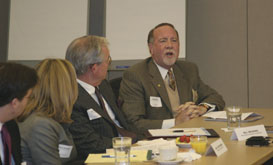As an example of an agency that has prospered through collaboration, Bob Dunn cited Operation Breakthrough, which provides a range of services to inner city families and is “the best kept secret in Kansas City.” Dunn told of how early on the center director told his father, Bill Dunn, that they could not afford to hire a development director. Bill answered, “You can’t afford not to.” Since then they have established collaborative relationships with a number of Kansas City area hospitals and have benefited greatly from the collaboration.
Kala Stroup noted that her organization, American Humanics, has entered a cooperative Down-town office arrangement with Camp Fire USA. Although not a health care-specific organization, American Humanics is itself a collaborative arrangement among colleges, universities, and nonprofit organizations that aspire to educate professionals for future leadership roles with their institutions.
“Collaboration is a buzz word,” Bill Bruning cautioned, “but it means giving as much as taking.” Bruning has been impressed by the cooperation he has seen among funders, but sees “little evidence” of the receiving agencies yielding core functions or sharing critical information.
Rex Archer also saw a “weakness in collaboration” in that the regional health care organizations “have never created a shared vision of real issues.”
Davoren Tempel admitted that it would be “difficult to make [collaboration] work.” That much said, she sees signs of where it is working and cited several of those efforts, particularly the collaborative effort between Children’s Mercy and Kansas University on the subject of obesity. “I can see it beginning to happen in Kansas City between all these partners,” she predicted.
The Life Science Movement
One area where the collaborative spirit is being tested is the area’s ongoing life science movement. “If we are to be able to make real progress,” said Tempel, “the universities need to be working together on specific projects.” Tempel specifically cited the need for cooperative work on funding. She argued for the kind of public private partnerships that Kansas is now pioneering.
 Dr. Mark McPhee of Saint Luke’s discusses the importance of the life sciences movement and its many benefits to the Kansas City area.
Dr. Mark McPhee of Saint Luke’s discusses the importance of the life sciences movement and its many benefits to the Kansas City area. Mark McPhee reinforced that point. He observed that donors add leverage to their philanthropic dollars when they create an endowed chair or a professorship or a clinical research scholar. This allows area institutions to become more competitive in the national search for talent.
The Greater Kansas City Community Foundation has sponsored along with the Kauffman Foundation a report called, “Time To Get It Right.” As Larry Jacob noted, the report outlines a strategy to maximize resources in the two states to create a unitary life science front. It also deals with the issue of how to create a pipeline of talent.
As Jacob noted, his Foundation has also been involved in putting a referendum on the ballot for the fall 2006 election that would create a stable legal environment for embryonic stem cell research. “The polling right now is very strong,” said Jacob. “Once people are educated about the science it will be less divisive.”
When asked about a potential backlash, Jacob answered, “Is it a concern, absolutely? We try to find common ground when there can be some.”
“It’s purely an education issue,” said Peter Yelorda. He observed that some customers have already called to question Blue Cross’s support for the initiative.
Jacob did not see it purely as a matter of education. “There are people who understand the issue and disagree,” he clarified. The education process involves those people who are not yet up to speed, and both camps will have a chance to convince them.
“If the referendum loses,” asked Bob Litan rhetorically, “it doesn’t make stem cell research illegal.” He saw it merely as a public relations setback and not as a change in the status quo.
A loss in the November referendum would have “a chilling effect politically,” admitted Jeff Ellis. The referendum has been conceived to take “that uncertainty out of the environment.” He volunteered too that a “better word than education is dialogue.”
On the question of whether Kansas City could create a life science movement adapted to the culture of the area, Rex Archer spoke of the need for prevention research and the opportunities in animal health research “because of our history here.”